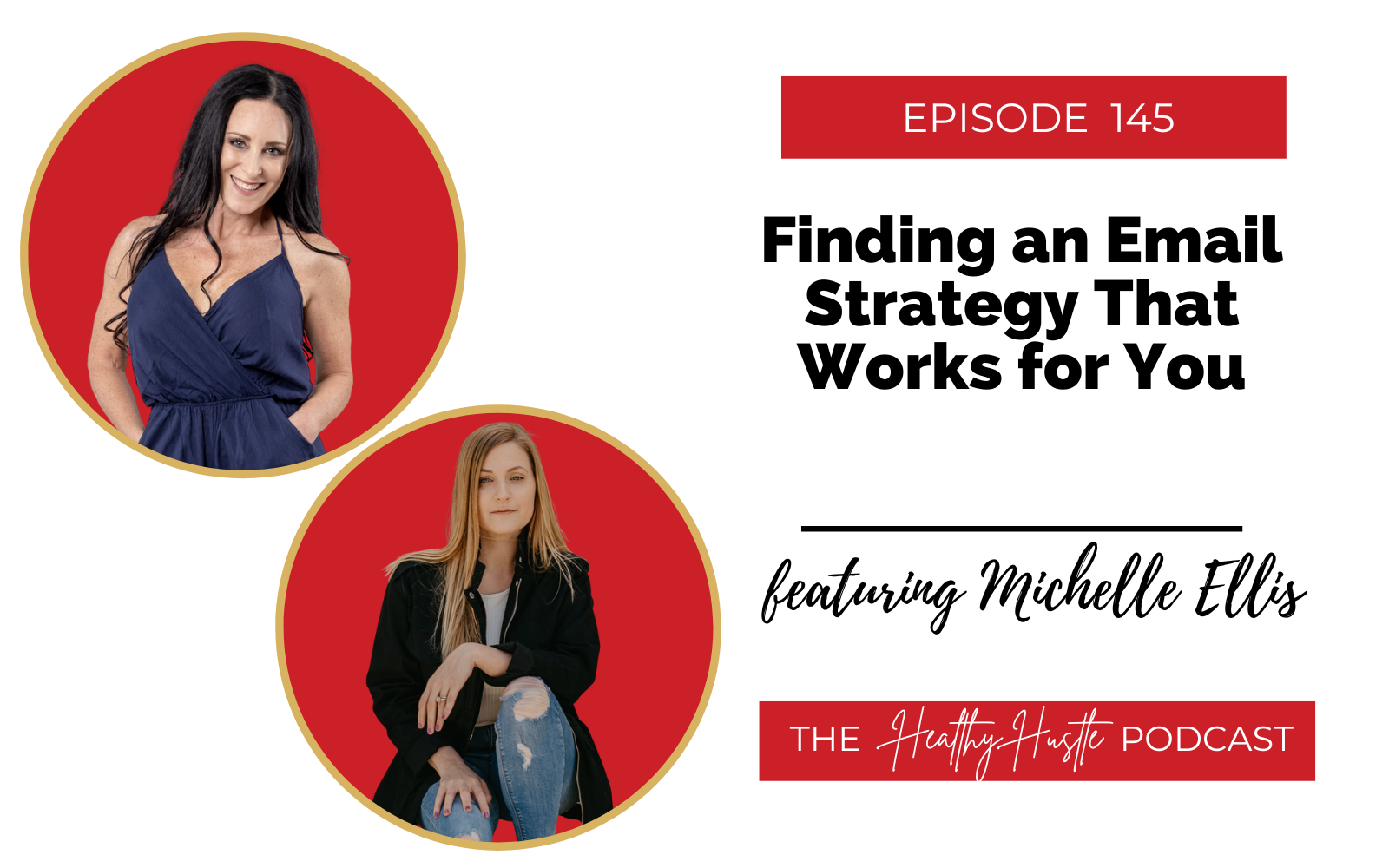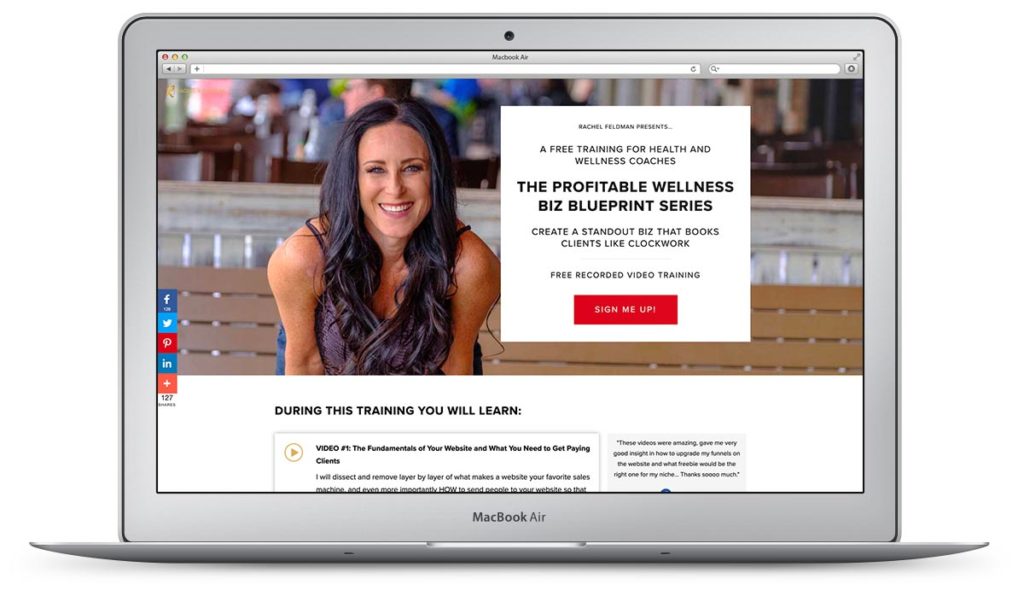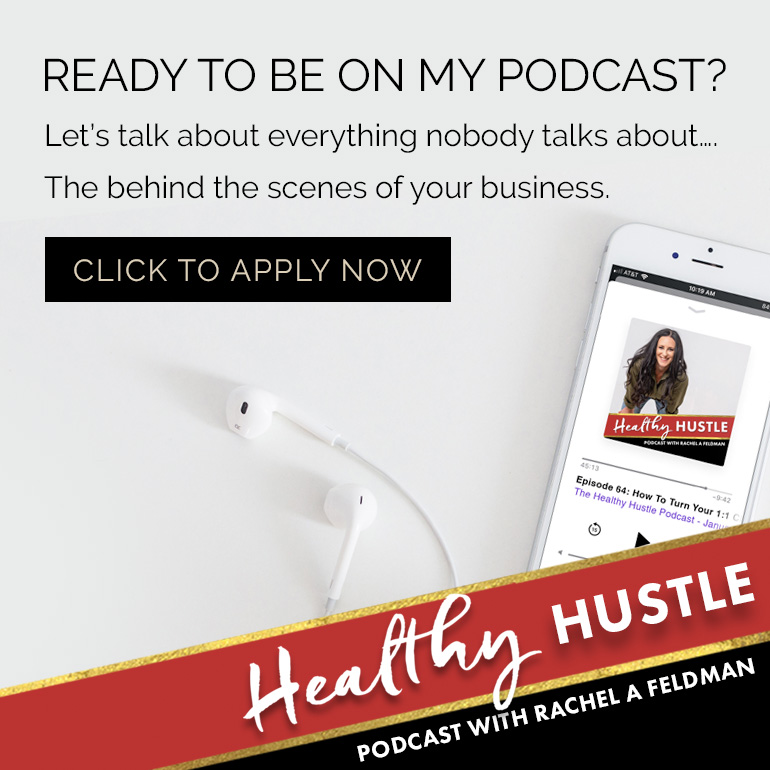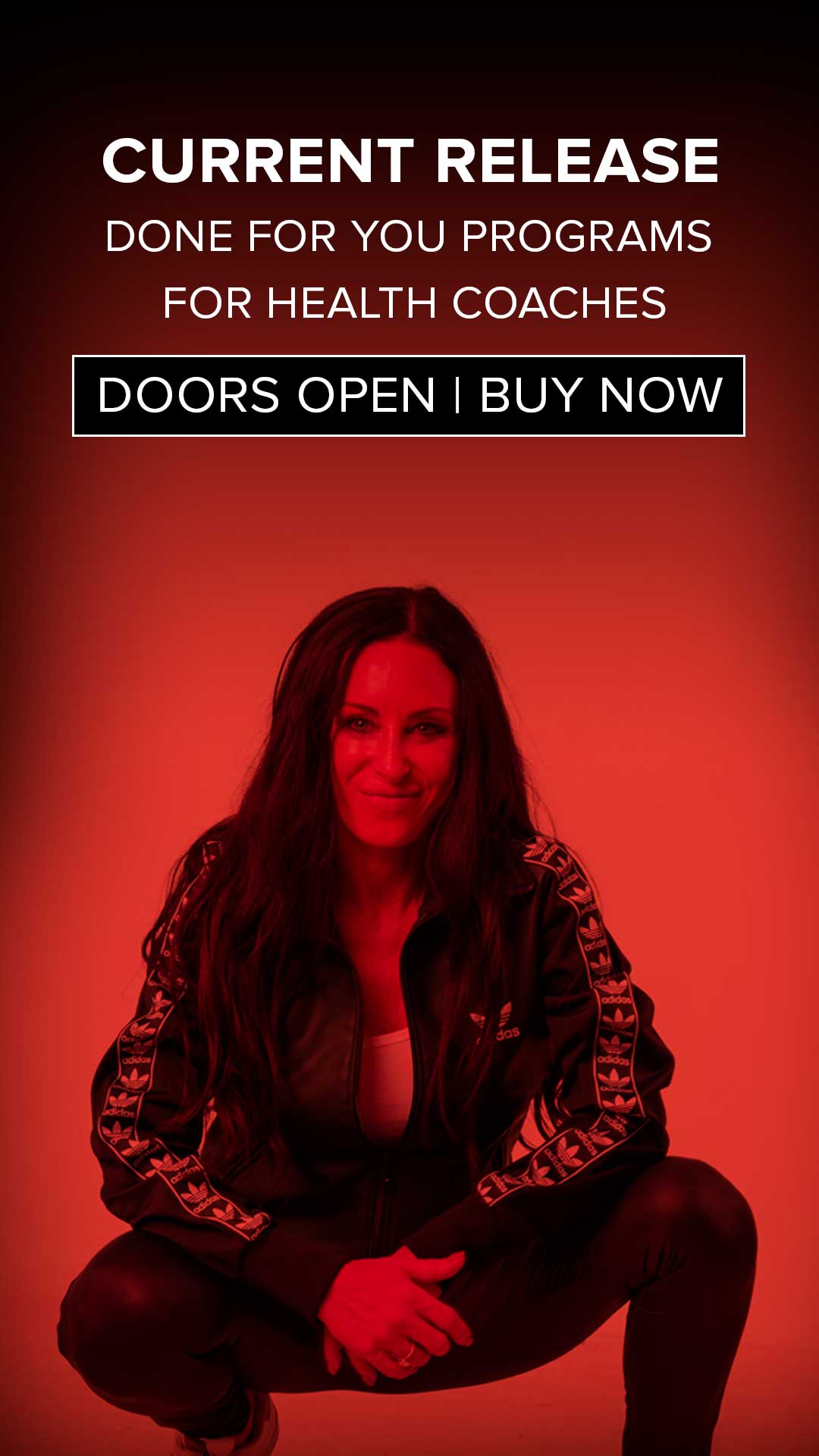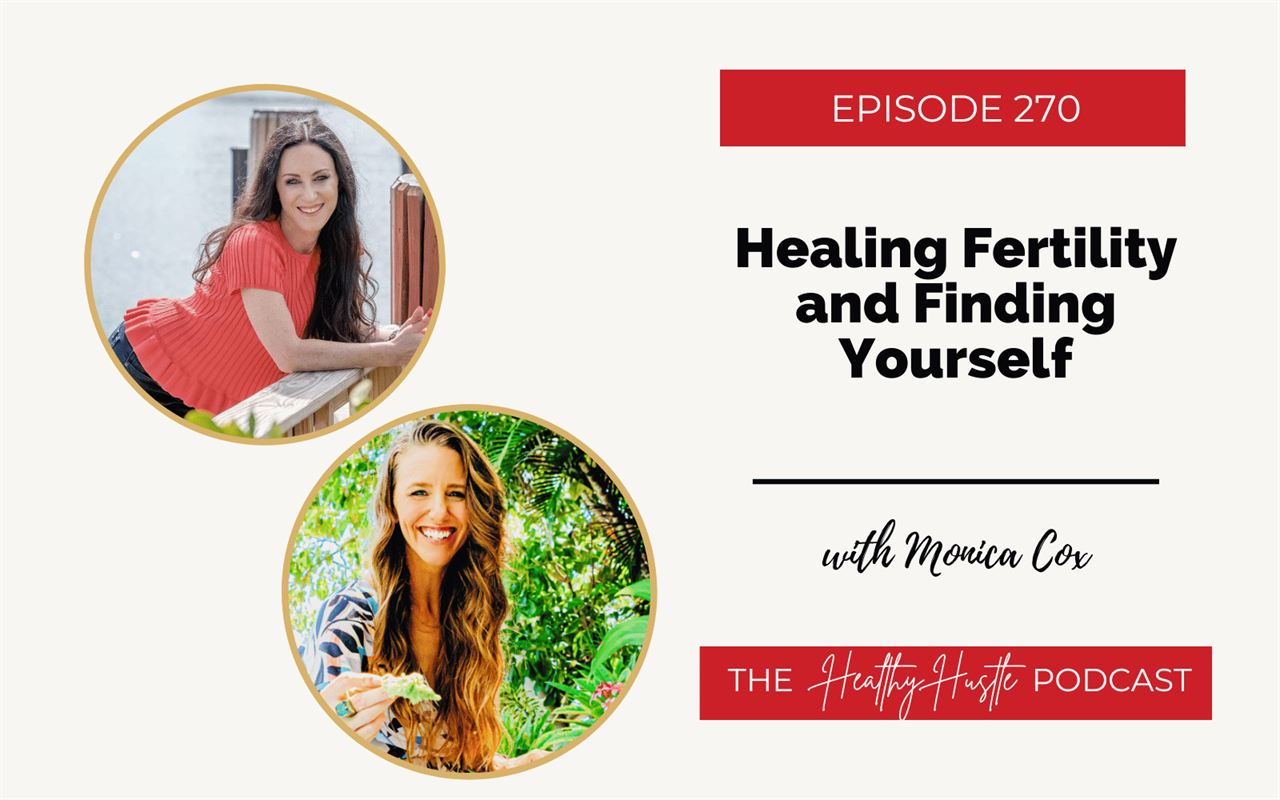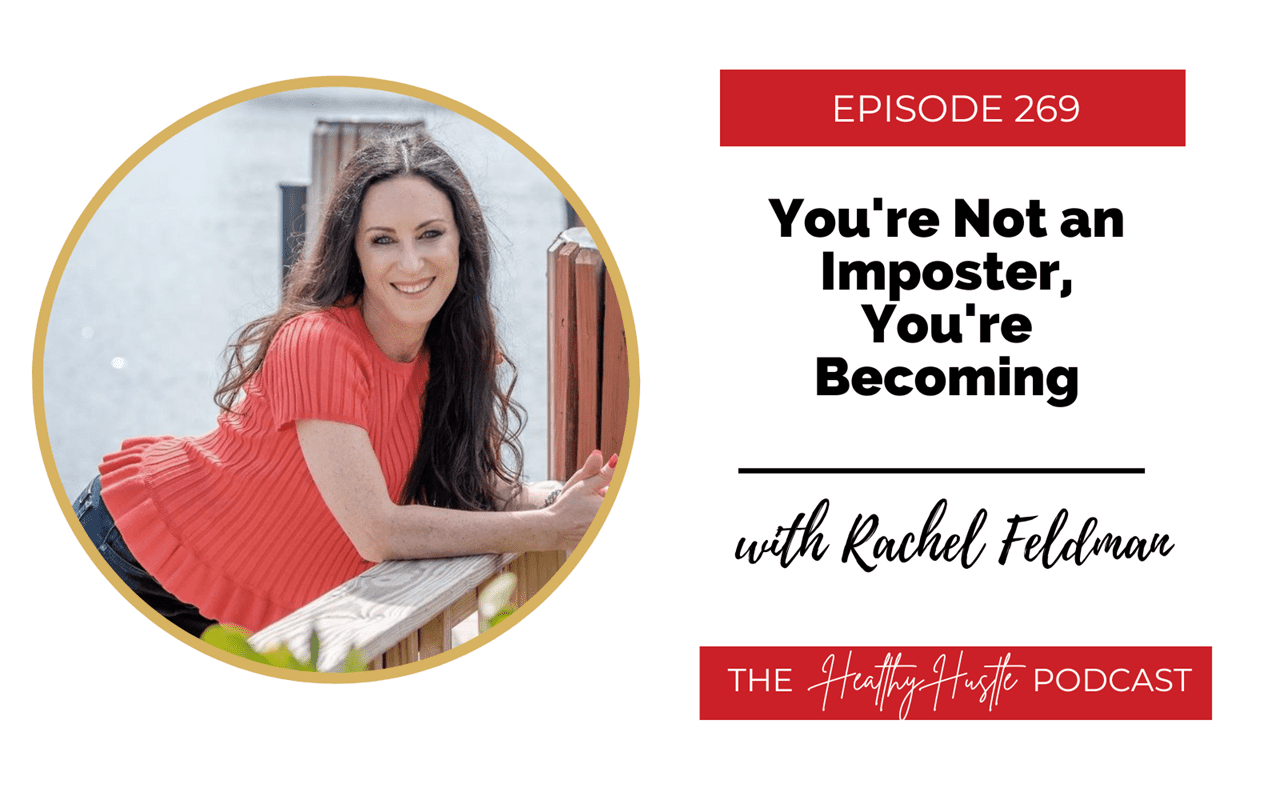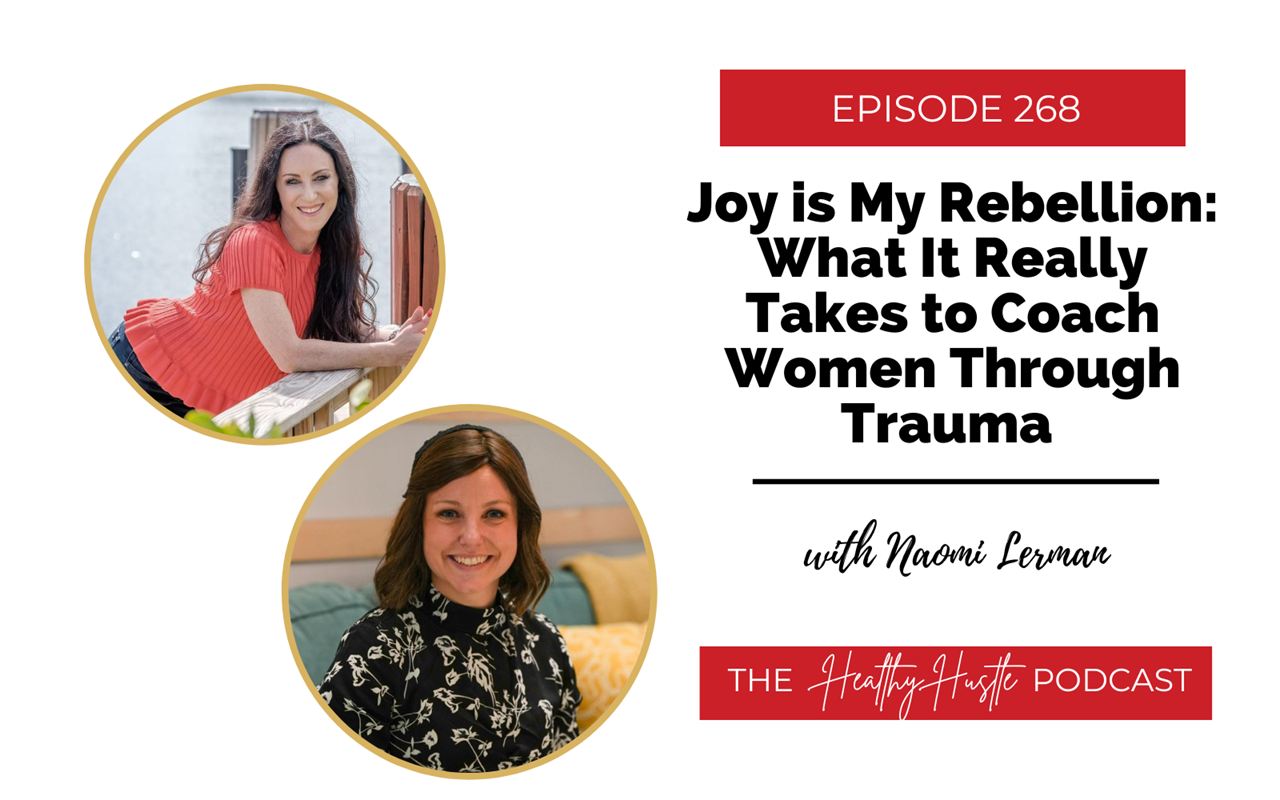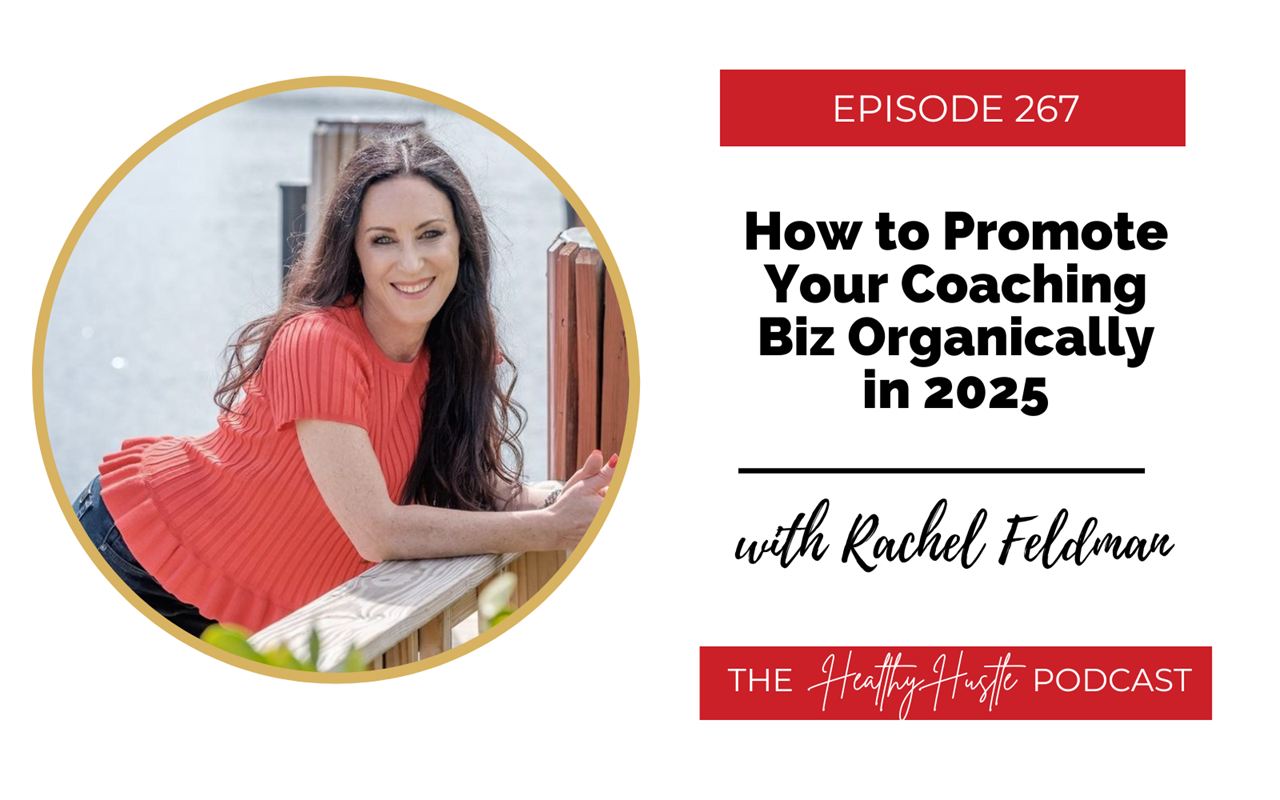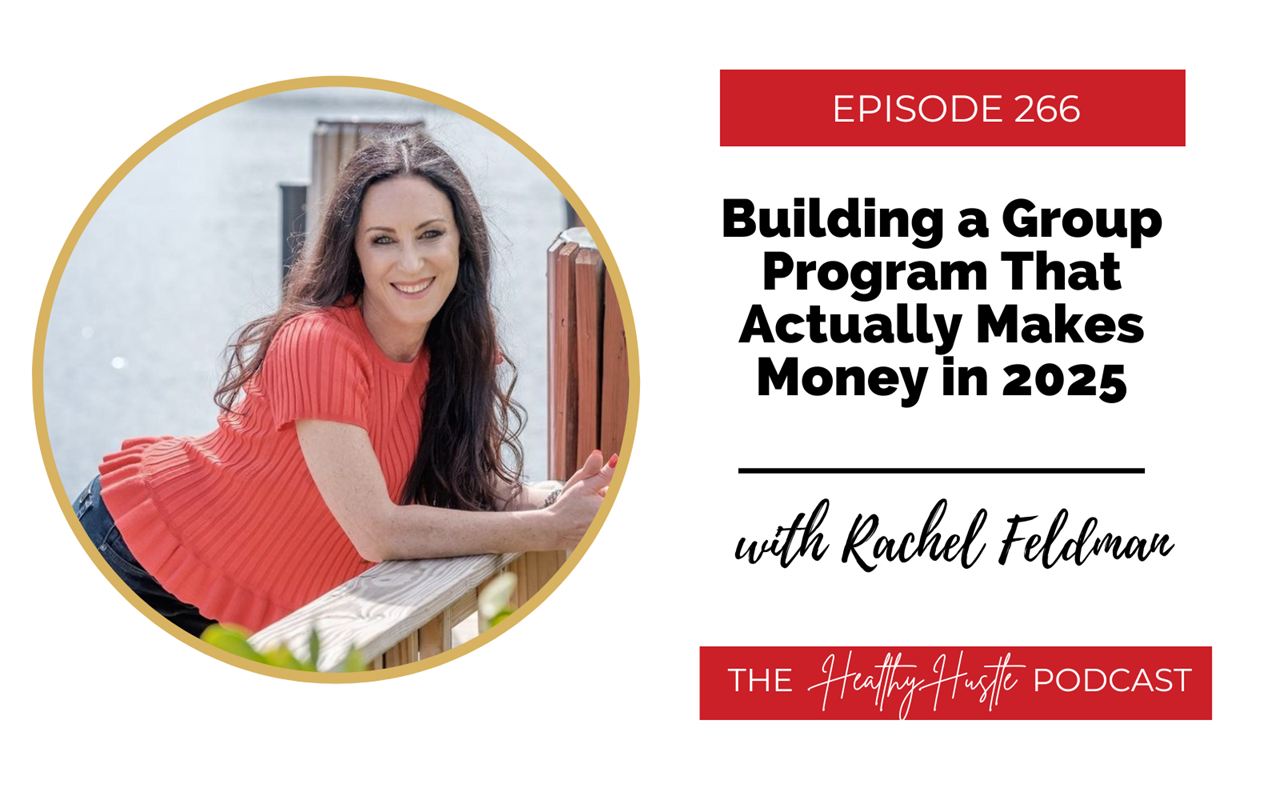Email marketing is a key piece to running a successful health coaching business. Why? Because emails are a fantastic way to connect with potential clients and warm them up towards your services using strategic email sequences and tactics that turn subscribers into paying clients.
Whether you’re new to email marketing, just getting started, or a seasoned pro looking to up-level your game, this episode is for you!
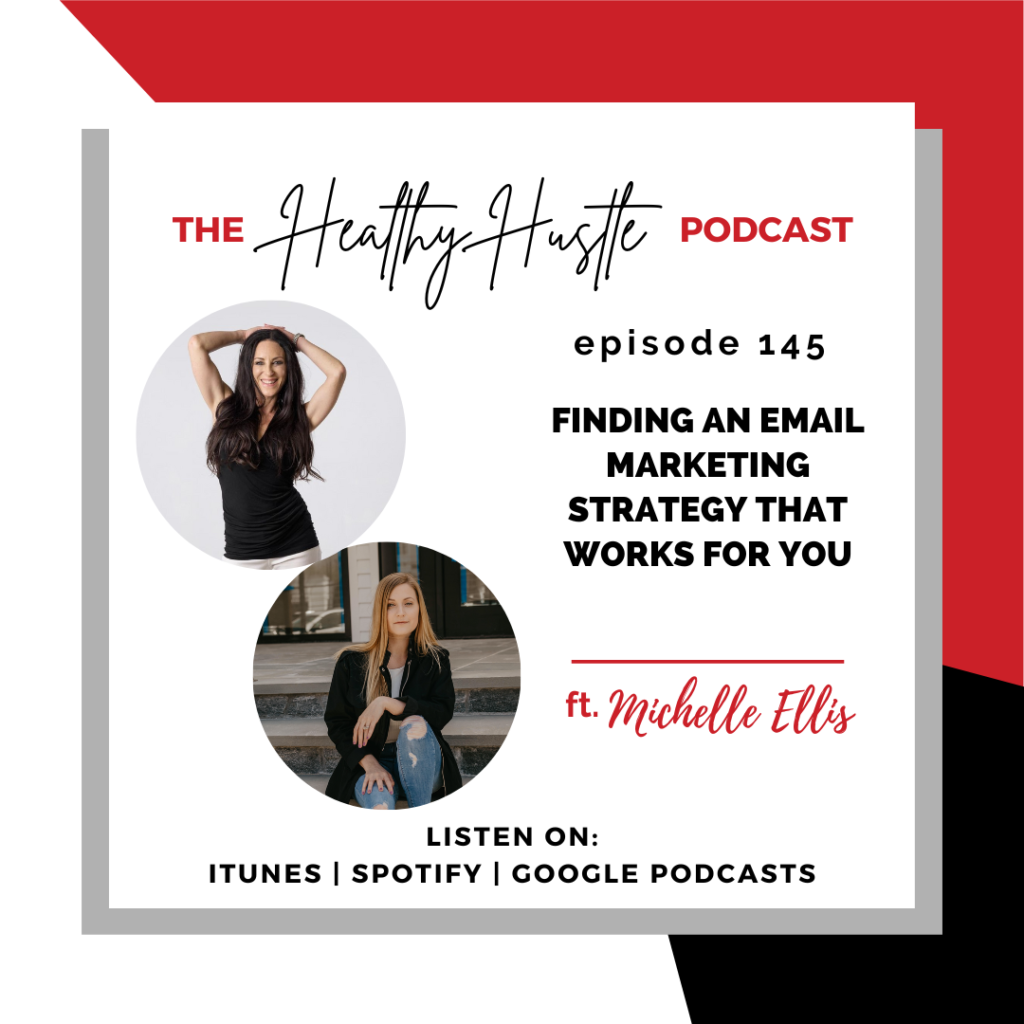
Michelle Ellis is back on the Healthy Hustle Podcast to talk about all things email marketing. We’re covering a huge variety of topics, including how to improve your email open rate, what to send your list when you’re feeling uninspired, why you need to master the art of storytelling within your emails, and how to optimize your email subject lines – plus so much more!
Connect with Michelle:
Michelle’s website: https://michelleellisco.showit.site/#/
Michelle’s Instagram: https://www.instagram.com/theorganiccopywriter/
Rachel: I always get asked by coaches, What is email marketing? What are the different types of email marketing? How do I get my potential client to actually open my emails? So today, we are diving into email marketing.
You might be in a situation where you’re nurturing your list or you’re launching – and we really want to talk about what you can do to increase those open rates. So today, I’m going to have Michelle break it down in a few different ways from a copywriting perspective. This is definitely her wheelhouse. All right, Michelle, let’s talk all email marketing. Tell me the difference between the different types of email marketing.
The Difference Between The Different Types Of Email Marketing
Michelle: There are many different types of email marketing, segmentation, and all kinds of things like that. So I think to keep it super simple and for health coaches to really look at the two most important types.
You’re either in a nurturing phase for your email list, which is when they first opt-in, and you send them nurture emails or when you send your nurturing newsletters, however, frequently you’re doing that.
Or, you’re usually in a promotional launch type, whether you’re promoting something that you’re offering, or you’re cross-promoting, or you have a network marketing product that you’re promoting. So those are usually the two ways that health coaches are usually in whichever phase.
Nurturing is really more about providing high-value content and keeping your email list engaged, keeping them excited and interested, eager to open up your email they’re getting something super valuable about it, they’re learning something. And that might even include super high value, no opt-in masterclasses or
Rachel: The strategy that you and I used during a launch, we actually did two nurture emails where it was open up, no opt-in required, grab this Canva template, and the other one was, grab these blogs, just to get people used to opening up that email so that when those promo emails came, they weren’t errant. We were already in the mood, which email marketing is all about. It’s kind of like dating and nurturing your ideal client to get to that place where you actually commit.
Master Storytelling Within Your Emails
Michelle: Exactly. And then with the promo, especially just coming from the coaching background and being a health coach myself, in any kind of coaching in general, your emails are an opportunity to coach your reader a little bit.
So it shouldn’t always seem like, oh, I have this great offer for you for X amount of dollars. It should really be Why do they need it? How can it work for them? Show some proof of how it worked for other people from that story-driven approach. Even if you don’t have clients yet, you can start with your own story or family or people you’ve helped. There’s always a way to spin a story into the mix and really connect with your readers when you’re in a promotional sequence. So it doesn’t always seem that, for lack of a better term, bro type of marketing. Super salesy no one really wants to always be sold on.
Rachel: We identify with stories. One of the best things for social media strategy, which we’re not talking about right now, is story tripping. We talk about showing up on social media, your why behind the scenes, your story, your inspiration, and not that our whole business is about us. But we want our ideal client to identify with us and identify with the stories that we’re telling so that they do warm up to us and go on that date with us and eventually become paying clients.
Michelle: Absolutely. When you can nail down those two aspects of marketing with email marketing, then you can branch off and segment your list a little bit more. Just to give a general overview, if somebody clicked the link on your sales page on your promotional sequence, but they didn’t buy, maybe you fire off an abandoned cart sequence. Or maybe somebody said they were going to register, click the link to register for your masterclass, but then they didn’t show up. So there’s advanced segmentation and there’s advanced email marketing.
If you can master nurturing then anytime you send an email or every time you have an opt in of any kind –if you master that story driven type of approach for promotional marketing– then you can step into the advanced level marketing without stress or having missing pieces beforehand and have a clearer picture of what that advanced segmentation is going to do for you and actually targeting the goal and what that segmentation is for.
How To Improve Your Email Open Rate
Rachel: Let’s talk about sending an email when that person has not opened that email, talk about email marketing strategy where you can resend to those people.
Michelle: The one thing that I’ve done ever since they came out with it on my email platform was to resend unopened. Because a lot of times people might think, well my emails are dead or emails aren’t working. But you don’t have to change the email because the open rate wasn’t great.
Almost every single platform allows you to just fire it off again. You can resend to an unopened and the default setting is usually resending it with the subject line. But I wouldn’t do that, I would change the subject line or say something like, you missed this or something to pique their interest and then they tally it. So you’ll see your open rate increase, sometimes by maybe 15, or 20%. More people have opened it, and then you get a combined open email rate.
Sometimes it’s as simple as the wrong timing of sending your email, or they were just busy. Or maybe you didn’t know your ideal clients actually go on their computer or on their phone.
Rachel: That’s a great point that you just brought up. There was a time where Monday morning was the best time, then Thursday morning. I think we’ve tried out all different ones. Night emails have great open rates for my ideal client, because they’re sitting there on their phone getting ready for bed. We wouldn’t say that’s the best for biohacking. A lot of people scroll that email. I’ve done Saturday mornings. I’ve really tested to see what works for me. I find that the six o’clock email really works best for my list. But it’s finding what is the best time that your ideal client is going to be opening that email.
Michelle: Yeah, I think a lot of that might even come intuitively, really thinking about your ideal client. I have so many people ask me, “What’s the best open times?” I’m like, I can show you studies, but they change every year. Sometimes they change mid-year. If you look on HubSpot, they’ll tell you 6am and weekends are better. But it really depends on when your ideal client is free. If you know that they work a nine to five, it would make sense not to send emails from nine to five, unless it was their lunch break. You want to hit them either before or after.
The Importance Of Knowing Your Ideal Client’s Habits
Rachel: Exactly. I mean, if they’re at their computer and they have a desk job, you should just intuitively know what they’re doing. And a lot of times your ideal client is often you a couple years prior. So you know a little bit already. If you’re focusing on busy moms, they might check their email first thing in the morning, like me. Usually when I’m drinking my coffee. It’s something I do habitually for me.
So I just always look at it from well, who’s your ideal client? What are they busy doing? When do you think that they’re sitting down to open their email? Understand their habits and really understand what their day is like?
I think it’s important when we’re also crafting our emails to bring that intuition into our emails and to really sit back and say, What would my ideal client look at as a high-value email? When you’re nurturing or even promoting, really there and think of that person getting that email and their life during the day that they’re experiencing? What’s actually happening for them?
You might even be able to get some insight into mobile use. So if you have a free Facebook group and you look at your insights, it’ll tell you when your members are most active, it’s it might be a shot in the dark, but it’s worth it to test that same timeframe, because typically most people who are using social media on their phone, they might have their pinged notifications on. So if you send an email, you’ll see it.
So anyone who has a free Facebook group, coincide it with the timing of when their members are most active to when it’s best to send emails unless, obviously, you’re in a promotional launch and things are timed, like your 24 hour or 12 hour webinar promotion emails. They’re gonna be timed to 24 hours until the last 12 hours until the last reply.
Rachel: So it’s really more for if you’re looking for more engagement and your nurturing side of things. Definitely lean into some of the data you already have. Depending on your email marketing platform, you can optimize the send time based on the data
Michelle: And you can sometimes send it based on their timezone.
The Different Types Of Email Subject Lines & How To Optimize Them
Rachel: I have to admit, I don’t always do that. I send a proven time that I find really works. But as we said, times change and we have to really keep our eyes peeled and collect data so we know what time it is. Let’s move on to the next email subject lines. I know there are a lot of email subject lines, different types of email subject lines. So can you talk to us about that?
Michelle: So there are curiosity-driven subject lines, where you’re not telling them exactly what’s in the email, but you’re just leaving a little curiosity like, Hey, want to know how you can get whatever the result is? So you’re not telling them in the subject line what’s in the content inside. They have to open it up to figure that out.
Also, emojis! So aside from the copy, if you’re an emoji lover– even just looking at my own inbox, I have a lot of email addresses, personal business, things like that. And I noticed in one of my spam email accounts that I have that I’ve just signed up for a ton of stuff, and they just flood my email inbox. The ones that stand out are the ones with bright colors like red emojis. If there’s a sale, a flash lightning, if there’s a sale going on, I pay attention to those more than anything else.
Also, depending on which email marketing platform you have, Kajabi, Ontraport, and ConvertKit do this, but it’s really important to look at your spam score. You’ll see you don’t want your subject lines to be too long, you don’t want them to get cut off on a mobile device. Always send yourself a test, and make sure that you test just the formatting if you’re giving a high-value tip, the three ways to lose weight without dieting, or something like that.
You might want to capitalize each title case. But if it was just three ways you can lose weight, or, want to lose weight faster than dieting?– then don’t capitalize everything. Make it look like you just asked the question with a normal sentence. That’s the conversational-type subject lines.
Then they’re the ones that look almost corporate professional. Those are great if you’re sending a high-value blog, or a video, vlog, or something like that. So if it’s tip based, if it’s very blog style, I would say title case, that’ll stand out. Otherwise, do lowercase. You could even feature a client story. XX lost five pounds in my detox program. Here’s how. Just show some proof right there in the subject line, and get people excited to read it.
Make sure it goes right back to your niche and the problems that you solve for them. Make sure that your emails are always in alignment with what you coach on.
Rachel: Also really understand why people buy from you. I always ask coaches these questions when they’ll get on a discovery call: What are your client’s biggest problems? What do you want to help your client do? They usually say, I want them to feel better. I want them to feel lighter. Generic stuff that we tend to say when we’re at the infancy of our coaching, or when we’re not clear.
But when we get into the problems, I always say, well, here’s a list of the symptoms, but tell me what this person wants to achieve. Really knowing why they buy from you and having some of those nurture emails, and also that promotional, lead to the reason that they want to actually buy.
What To Send Your List When You’re Feeling Uninspired
Michelle: Yeah. It’s so important to be relevant to what they’re looking to solve. I always get with all the coaches I’ve worked with over the years, I always end up on their email list because I always test emails, right? So I still get them and I look at things and sometimes it does boggle my mind when I see someone sending an email that has nothing to do with what they coach on.
Don’t just always find something to send. Make sure it’s quality. Sure, there are times that I feel uninspired behind the scenes. I’ve been seeing a lot of entrepreneurs coming out and talking about how we have different seasons, where we sometimes feel totally uninspired. If it’s a season that I’m in, cool. I’m going to say, What PowerPoint presentation could I send? What video could I send?
We don’t have to just send something to send something. We can really sit there and think, What can I actually do for my list? What freebie could I give this month, and then base all my nurture emails off of that. Sometimes there will be a time where we just say, I’m not sending an email, it’s important to be really consistent, but it’s also important to not send shit.
Rachel: Exactly. Honestly, I see it all the time. And it’s so important when you’re running any type of business. I recently just caught a story from someone who had a very big following, 1+ million and they’re taking a mental health break.
I just think it’s really important to normalize that. Don’t just do it because you think you have to do it. Maybe your email marketing could just be leading to a discovery call, maybe you feel like serving on a discovery call, but you don’t want to create. You don’t want to send something else. Do that. Or maybe you want to lead them to a free masterclass and not have to worry about getting it all together in an email. It can be so simple. So it’s really just important to make sure that it feels aligned as well.
Michelle: I think it’s important to bring this up, because I do love that you talked about normalizing that. I know there was a time when I really had to step back. I see a lot of entrepreneurs doing the same. I know one who has a huge following and took an eight-week social media break. But she’s still consistently sending emails. I would say it wasn’t every week, it was more bi-weekly, but emails that were also talking about why she took this break and being transparent in the moment.
It’s important to sit there and say, especially if you have content from us, you can always take a blog from that program folder, and turn it into a newsletter. We also have the newsletter package. But you can also go into a freebie that you have or a program and pull content from a program. You can make it super easy. And who doesn’t love recipes when all else fails?
Rachel: It’s so true. And that’s going right back to your niche and knowing your signature programs and knowing your signature freebies because if you had those to pull your content from then it won’t feel so overwhelming. I think a lot of times people don’t know their niche yet or you’re still discovering it.
Pulling Stories From Your Own Life & Not Comparing Your Emails To Others
I’ll never forget sending an email that I put together at the last moment because I had gained four pounds overnight. I was like, what is going on? Has my probiotic stopped working? I gained four pounds overnight! I used this curiosity subject line. I said how I switched my probiotic, what I did to de-bloat, what I did to get all that excess water out, and I landed five clients just from that email. It was even during Christmas time –the perfect time to send something like that. But it was easy to write because I had that symptom list. I knew what to write, it was easy and I led people straight to a discovery call.
Michelle: Yeah, and you also pulled from your own life truth and your own story, which I think is really important. A lot of times, when people face those road bumps, when it comes to email marketing, it usually comes from the place of you seeing somebody else’s email. You’re wondering how you can make your email look just as good as theirs.
And there’s that competitiveness. Not on purpose, but it’s that comparison thing going on. And just saying what you really want to say, and showing up how you really want to show up, that’s really going to help you nurture.
Rachel: I’ve also been seeing people talk about showing up authentically. It’s very hard if we are going through a bump in our health, or we’re going through a journey. It doesn’t mean you have to tell everything, but it’s very hard to show up. It would be very hard for me to show up if I didn’t say I was in extreme burnout last year, to the point that I felt depressed and anxiety and all that stuff. It would be complete BS me being like, Oh my God, living my greatest life, which I am living my greatest life. But this was something that really happened, that I’ve been able to make some major changes in my life, restructure my business, restructure my mind, rewire all these things. And those are things that I talk about.
Let’s go into social media strategy.
Michelle: It’s the same thing. Even just thinking about what the whole world went through. I watched this really cool movie yesterday, called Alone Together with Katie Holmes, and it was about the whole pandemic and the situation that happens with a cute little romantic love story. But it was kind of crazy because it showed visually what we all collectively went through in the entire world. The moment they had to put masks on for the first time, and they couldn’t even order from the restaurant and things were closing down, and all these crazy things.
Not only did we all go through that but we’re still seeing the aftermath of how that actually affects our mindset and how we show up in the world, because the world changed. And your clients are dealing with that too. So really speak to them on that level of how to deal with it –especially if you’ve gone through this health journey similar to your client or you’ve dealt with it or use it in some capacity. So be really honest in your email marketing, but with the solution.
Rachel: Whether it’s social media or list building, that authenticity is important. But we don’t want to just have our social media and list building be a diary. Really think of what is the problem? What’s the solution? How are you handling it? How can it benefit that radar?
Michelle: Exactly. And sometimes it’s to inspire them and think about it from your niche perspective. If you’re a hormone coach and you’re looking back at the world, let’s say in the last two years, did that trigger anything in your own hormones? Or maybe you noticed an influx of clients coming in. Did you experience stress hormones? Talk about relevant things happening in the world and how it affects your client’s health.
Rachel: I love that. Well, this has been a jam-packed episode on email marketing, I would say, most importantly, know your calendar, look at your promotional dates. Take out a calendar, go week by week, what am I sending and nurturing now? Maybe you’re doing bi-weekly newsletters. I did that in the beginning stages of my business.
I went through a time when I didn’t send many newsletters. But I find that the best way to keep your list engaged is definitely to nurture them to give them high-value information. Also, know why your client is buying and have a great product. Because when you promote and you do your webinars or you lead people to a master class, they’re going to come when the message is clear. They’re going to come when your emails are clear, and they’re going to buy from you because you’re solving a problem. So never forget that when you’re showing up anywhere in your business.

